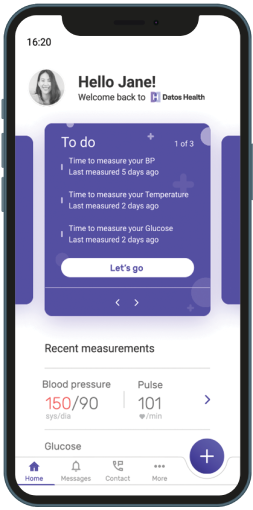
Health happens all the time, not just during provider visits.
Historically, clinical decisions were made based on the ‘snapshot in time’ taken during medical encounters. The more subtle variances in our health indicators that happen between visits, along with the important stories they might tell, have remained largely concealed from health professionals.
We are in the dawn of a new age of hybrid care delivery with Datos Health’s remote patient monitoring platform. Patients can now be monitored and cared for remotely between visits to capture not only vital signs, but also adverse symptoms of disease and medication reactions as they happen – paving the way for earlier provider intervention, automated assisted self-care, and better health outcomes.
Prioritize actionable patient data and enable clinicians to focus their time where it’s needed.
Timelier interventions, better results
Patients with a range of needs, from episodic to chronic care, can be put on personalized, automated remote care plans with Datos Health. Frequently captured measurements and responses to symptom surveys can trigger automated responses from the system based on the provider’s workflow, or send escalation alerts to the care team to determine if intervention is needed. In many cases, automated intervention will suffice – for example, suggesting an OTC medication to alleviate mild symptoms or gather more data through automated questionnaires to determine the next best step.
In instances where medical intervention is warranted, care teams can pre-determine how escalation alerts are handled such as prompting the patient to set up an appointment, or connecting directly to the provider’s office via phone call or virtual visit. The ability to intervene when necessary leads to a reduction in rehospitalizations, faster medication titration, and improved quality of life for patients. Care teams are also alleviated of many tasks that can easily be handled by automating their workflows, giving patients the care they need when they need it.
Results-based patient interactions
As medical technology develops, increasing amounts of patient-generated data are created. The challenge for providers is to balance meaningful clinical interactions with workflow efficiency. With the right tools in place, adding a digital arm to existing workflows will reduce clinician workload instead of increasing it.


